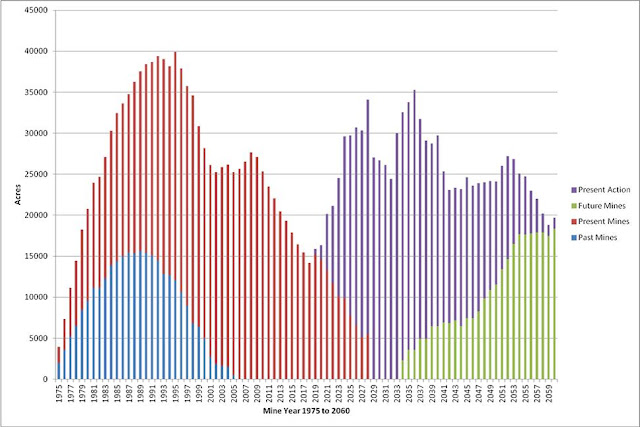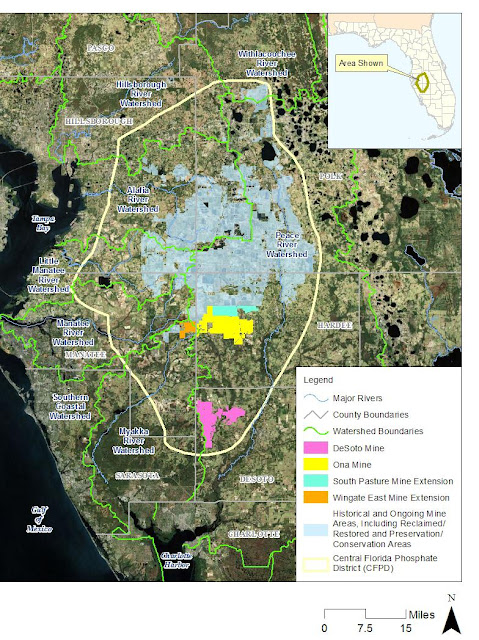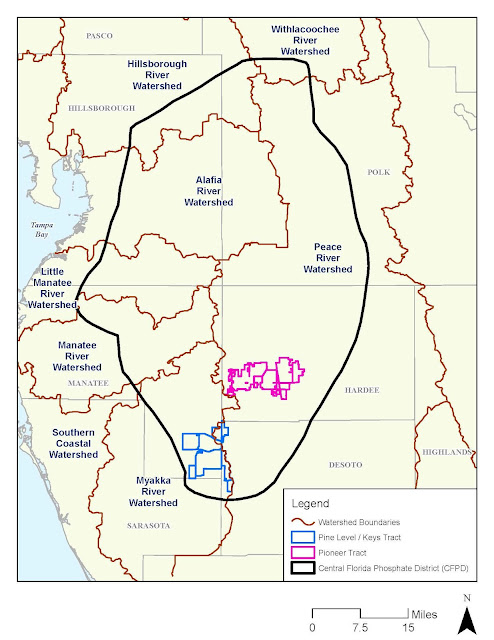Areawide Study for Florida Phosphate Mining is Badly Flawed
The Florida Chapter of the Sierra Club, ManaSota-88, People for Protecting Peace River (3PR), and Protect Our Watersheds (POW) on July 25 filed extensive joint comments on the U.S. Army Corps of Engineers Draft Areawide Environmental Statement (DAEIS) for phosphate mining. We pointed out that the DAEIS is flawed in several serious ways.
A chart which appears at 4-191 of the DAEIS illustrates many of the problems:

This is a chart of acreage of mined and not yet reclaimed areas from 1975 to 2060. The areas in the graph are also the areas in which all surface water is captured by the ditches and berms of the mines, and it is sometimes called the "capture area." The chart shows that the capture area has gotten better since its high of 40,000 acres in about 1995, but, with the new mines considered in the DAEIS it's about to get much worse, going all the way back up to over 35,000 acres. And the continuing damage continues for decades. While the graph ends in 2060, one can see that the capture area/mined and unreclaimed land extends beyond that, into the 2090s in fact.
So, while the mining companies tell us that things are much better than in the past, in fact most of the major insults of mining, the vast areas of mined and unreclaimed land, including wetlands, and the surface water capture, and the groundwater pumping, are actually continuing or getting worse. We're about to enter the second significant era in mining in central Florida. While there is great disagreement about whether the companies can reclaim wetlands sufficiently, the fact is that whatever inadequate reclamation they do won't occur for decades.
Estimates in the DAEIS differ from page to page. Of the mines immediately proposed, Ona, Wingate East extension, South Pasture extension, and Desoto will involve over 51,000 acres; and will destroy almost 10.000 acres of wetlands and over 49 miles of streams. Future mines, Pine Level/Keys and Pioneer, will involve almost 50,000 acres and destroy 15,000 acres of wetlands.
The DAEIS does not provide a map with all past and future mines, but an idea of the extent is suggested by combining the following two maps. First past and presently proposed mines, then the two additional mines coming somewhat later:


The phosphate mining companies pump extraordinary amounts of water from the Floridan aquifer to use to slurry their phosphate matrix from the mine to the processing plants and to slurry the clay and sand back to dispose in the mines. Mosaic alone is allowed almost 70 million gallons per day on average. This is more than 3 times more than is used by the entire downstream Peace River Manasota Water Authority's 200,000 users. And claims by Mosaic that it recycles 95% of its water doesn't mean they pump less, it just means its water use, for slurrying for example, is actually 20 times its pumping rate. The water the companies pump is free, it is simply allocated to them by SWFWMD.
And the damage from mined and unreclaimed lands and wetlands is not just to the surface water and groundwater. A study (by NASA, NOAA and other scientists) presented with the Sierra comments concluded that the draining of wetlands and elimination of land cover in the past had contributed to localized climate changes with less rainfall and higher daytime temperatures in the rainy season, as well as lower nighttime lows. So the water is not only impounded by the mines, there's also less rainfall to begin with.
These lost flows will impact streams like Horse Creek, where three mines are scheduled, as well as downstream uses like Charlotte Harbor, where reduced flows can result in changed salinity levels and impacts on species, including the endangered small tooth sawfish. These changes were not studied.
The Environmental Groups' criticisms of the DAEIS also addressed the failures of wetland reclamation, the failure to do a cumulative analysis, adding the damage from proposed mining to that of past and current mining, the failure to consider increased radioactivity at mined lands, and, astoundingly, the failure to consider the impacts of mining gypstacks in which the waste from fertilizer plants is stored forever in giant phosphogypsum stacks which frequently spill their acid wastewater in times of rain. Gypstack spills have been an ongoing problem in Florida, with the state diverting hundreds of millions of dollars from state mine reclamation funds to clean up rivers and harbors damaged by spills from stacks like Piney Point.
Sierra Club retained Professor Richard Weisskoff from the University of Miami to comment on the economics of the DAEIS. Weisskoff pointed out that the DAEIS conclusions that phosphate mining had a net economic benefit failed to consider many of the economic benefits, including the employment, of the agriculture which it replaces. The jobs comparison, for example, is not close, with roughly 10 times more agricultural cluster jobs than mining cluster jobs. And the cash from agricultural inputs tends to stay in Florida, while a good part of the mining profits go to the mining company parent.
Weisskoff also studied the world phosphate market. Here his results are eye-opening. Contrary to common perception, the world has a great deal of phosphate reserves, much of it in stable reliable source markets. The US has only 1.2% of world reserves. BUT, the US produced 14.9% of the world phosphate rock in 2010 (down from 25.3% in 2000). The US exports no phosphate rock, instead it turns its rock into fertilizer (at the fertilizer plants which produce gypstacks) and exports exports it. Over 27% of phosphate fertilizer exports worldwide are from the US. In other words the mining companies are basically fertilizer export companies, using up a phosphate resource which is limited in the US, but widely available in the rest of the world. They have a low cost advantage in their competition for the global market because of low taxes, high quality rock, access to transportation, free water and minimal land reclamation costs.
The citizens of Florida and the Florida environment are subsidizing the phosphate companies.
There is still time to comment on the DAEIS and urge that it recognize the damage being done to the Florida environment. The deadline for comments is July 31, 2012.
You may want to urge the Corps to recognize the multiple impacts on our groundwater and our surface water and wetlands from mining; ask for an analysis of wetland and stream damage and the problem of long delays in replacing these important features, ask the Corps for a full study of the impacts of gypstacks and their spills; and recognize that Florida phosphate mining is not necessary for US or world fertilizer production and that Florida mining is being subsidized by Florida taxpayers and the Florida environment.